宾语补足语
宾语补足语

宾语补足语Object Complement一、宾语补足语的含义宾语补足语(Object Complement)放在宾语后面,用来补充说明宾语所表示的人或事物所发出的动作,或者说明宾语的状态、特性、身份等。
宾语补足语可以有不定式、分词(现在分词和过去分词)、名词、代词、形容词、介词短语或副词充当)。
二、宾语补足语的表现形式带有宾语补足语的一般句型结构为“某些及物动词(如make等)+直接宾语(名词或代词)+宾语补足语”。
宾语补足语在句子的表现法:1. 用名词(包括名词性物主代词)表示:His Father named him Dongming. 他父亲给他取名叫东明。
We consider Mr.Zhang an excellent teacher. 我们认为张先生是一位优秀的老师。
2. 用形容词(短语)表示:They painted their boat white. 他们把船漆成白色。
We believed the report untrue. 我们确信这个报告不是真的。
I saw him young and strong, and now he is old and worn. 我那时见到他,他年轻力壮,现在他已年老体弱了。
3.用不定式(短语)表示:You mustn’t force him to lend his money to you. 你不应该强迫他借钱给你。
Nobody noticed him enter the room.没人注意到他进了房间。
【注意】see, have, let, make, watch, notice, observe等动词后的宾语补足语用定语表示时,省略to,help后的不定式符号to可带不可带。
see sb do sth 而不用see sb to do sthhelp sb to do sth或help sb do sth4. 用现在分词(短语)表示:We saw her entering the room. 我们看见她正走进那个房间。
什么是句子宾语补足语举例

什么是句子宾语补足语举例句子是构成语言的基本单位,而句子中的词语则承担不同的语法角色,其中宾语是句子中的重要成分之一,可以进一步分为直接宾语和间接宾语。
当宾语被修饰或补足时,我们将其称为宾语补足语。
本文将介绍宾语补足语的定义以及举例说明其具体用法。
一、什么是宾语补足语宾语补足语通常由形容词、副词、介词短语、不定式短语、从句等构成,它的作用是对宾语进行进一步说明或补充性说明,起到修饰宾语的作用,并在一定程度上影响句子的意义。
在英语中,宾语补足语可以出现在及物动词后面,也可以出现在介词之后。
而在中文中,宾语补足语通常出现在动词后面。
二、例子说明1. 形容词宾语补足语形容词是最常见的宾语补足语之一,通常用于对宾语进行进一步的描述或说明,例如:例如:a. 他认为自己是最幸福的人。
在这个句子中,形容词“幸福”的作用就是对“他自己”这个宾语进行了修饰,使得整个句子更明确。
b. 她觉得自己的美丽可以超越时间。
这个例子中,“美丽”是形容词宾语补足语,它说明了“她自己”这个宾语的特点和特质。
2. 不定式宾语补足语不定式一般指的是“to+动词”的形式,作为宾语补足语时,它的作用是对宾语进行一些必要的解释和说明。
例如:a. 他不喜欢和别人争吵。
在这个句子中,“和别人争吵”的意义就被不定式“争吵”所补足,“争吵”是宾语补足语。
b. 他已经下定决心去留学。
这个例子中,“去留学”是一个不定式,作为宾语补足语,它表明了“他”的决定和行动。
3. 介词短语宾语补足语介词短语也是宾语补足语的一种形式,它的作用是对宾语进行修饰和进一步的解释。
例如:a. 学校需要大量的教师。
在这个句子中,介词短语“of teachers”是宾语补足语,不仅进一步解释了“大量”这个宾语的概念,还说明了学校有什么需要。
b. 她对这个问题很感兴趣。
介词短语“对这个问题”的作用是对宾语“兴趣”进行进一步的解释,让整个句子更加精确明了。
三、总结通过上述例子可以发现,宾语补足语在句子中起着非常重要的作用,能够让句子的意义更加明确,语法更加规范,让读者更好地理解句子的内涵。
宾语补足语
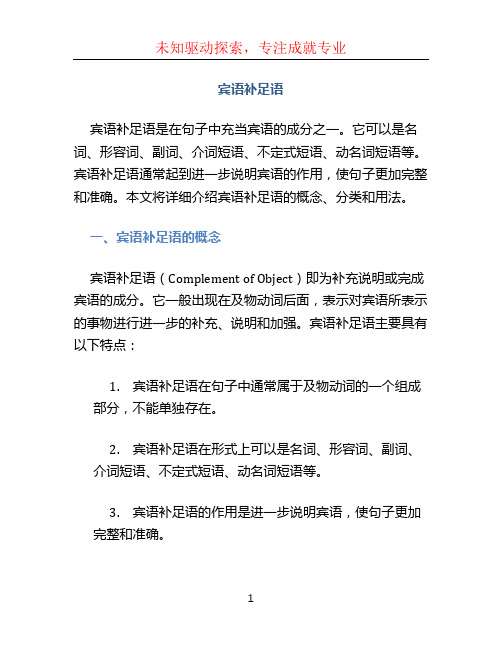
宾语补足语宾语补足语是在句子中充当宾语的成分之一。
它可以是名词、形容词、副词、介词短语、不定式短语、动名词短语等。
宾语补足语通常起到进一步说明宾语的作用,使句子更加完整和准确。
本文将详细介绍宾语补足语的概念、分类和用法。
一、宾语补足语的概念宾语补足语(Complement of Object)即为补充说明或完成宾语的成分。
它一般出现在及物动词后面,表示对宾语所表示的事物进行进一步的补充、说明和加强。
宾语补足语主要具有以下特点:1.宾语补足语在句子中通常属于及物动词的一个组成部分,不能单独存在。
2.宾语补足语在形式上可以是名词、形容词、副词、介词短语、不定式短语、动名词短语等。
3.宾语补足语的作用是进一步说明宾语,使句子更加完整和准确。
二、宾语补足语的分类根据宾语补足语所表示的内容,可以将宾语补足语分为以下几类:1. 名词性宾语补足语名词性宾语补足语是宾语的补足语是一个名词,用来对宾语进行进一步说明和补充。
常见的名词性宾语补足语有:•名词:我认为他是个天才。
•代词:我发现他是我。
•数词:他们选了三个代表。
2. 形容词性宾语补足语形容词性宾语补足语是宾语的补足语是一个形容词,用来对宾语进行进一步形容和补充。
常见的形容词性宾语补足语有:•形容词:我觉得那个电影很好看。
•分词:她把钱数得仔细。
•介词短语:他们把书放在桌子上。
3. 副词性宾语补足语副词性宾语补足语是宾语的补足语是一个副词,用来对宾语进行进一步说明和补充。
常见的副词性宾语补足语有:•副词:请你关好窗户。
•介词短语:他把字写在纸上。
4. 不定式宾语补足语不定式宾语补足语是宾语的补足语是一个不定式,用来对宾语进行进一步说明和补充。
常见的不定式宾语补足语有:•动词不定式:我打算去旅行。
•动词短语:她喜欢看电视。
5. 动名词宾语补足语动名词宾语补足语是宾语的补足语是一个动名词或者动词+ing形式,用来对宾语进行进一步说明和补充。
常见的动名词宾语补足语有:•动名词:我喜欢学习英语。
什么是宾语补足语
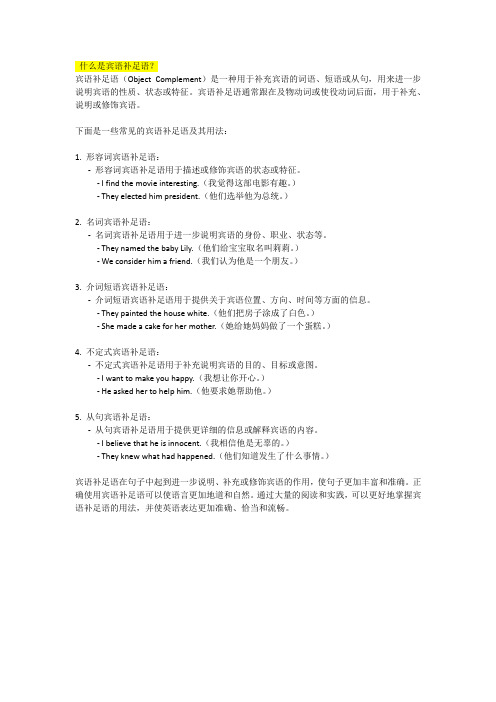
什么是宾语补足语?宾语补足语(Object Complement)是一种用于补充宾语的词语、短语或从句,用来进一步说明宾语的性质、状态或特征。
宾语补足语通常跟在及物动词或使役动词后面,用于补充、说明或修饰宾语。
下面是一些常见的宾语补足语及其用法:1. 形容词宾语补足语:-形容词宾语补足语用于描述或修饰宾语的状态或特征。
- I find the movie interesting.(我觉得这部电影有趣。
)- They elected him president.(他们选举他为总统。
)2. 名词宾语补足语:-名词宾语补足语用于进一步说明宾语的身份、职业、状态等。
- They named the baby Lily.(他们给宝宝取名叫莉莉。
)- We consider him a friend.(我们认为他是一个朋友。
)3. 介词短语宾语补足语:-介词短语宾语补足语用于提供关于宾语位置、方向、时间等方面的信息。
- They painted the house white.(他们把房子涂成了白色。
)- She made a cake for her mother.(她给她妈妈做了一个蛋糕。
)4. 不定式宾语补足语:-不定式宾语补足语用于补充说明宾语的目的、目标或意图。
- I want to make you happy.(我想让你开心。
)- He asked her to help him.(他要求她帮助他。
)5. 从句宾语补足语:-从句宾语补足语用于提供更详细的信息或解释宾语的内容。
- I believe that he is innocent.(我相信他是无辜的。
)- They knew what had happened.(他们知道发生了什么事情。
)宾语补足语在句子中起到进一步说明、补充或修饰宾语的作用,使句子更加丰富和准确。
正确使用宾语补足语可以使语言更加地道和自然。
通过大量的阅读和实践,可以更好地掌握宾语补足语的用法,并使英语表达更加准确、恰当和流畅。
宾语补足语七种类型英语举例
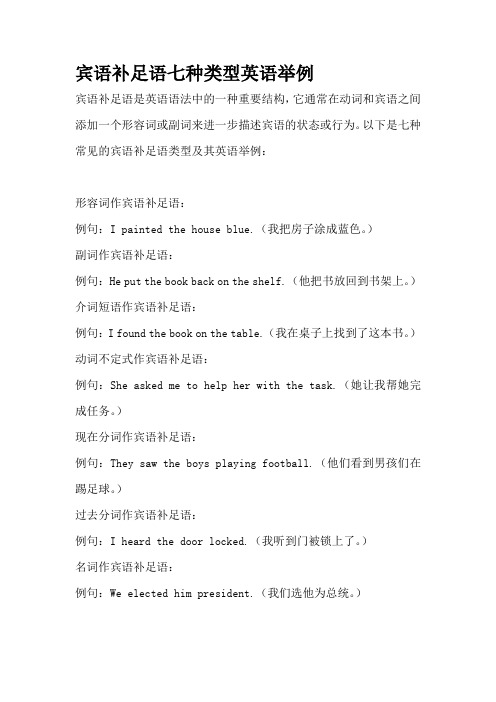
宾语补足语七种类型英语举例
宾语补足语是英语语法中的一种重要结构,它通常在动词和宾语之间添加一个形容词或副词来进一步描述宾语的状态或行为。
以下是七种常见的宾语补足语类型及其英语举例:
形容词作宾语补足语:
例句:I painted the house blue.(我把房子涂成蓝色。
)
副词作宾语补足语:
例句:He put the book back on the shelf.(他把书放回到书架上。
)介词短语作宾语补足语:
例句:I found the book on the table.(我在桌子上找到了这本书。
)动词不定式作宾语补足语:
例句:She asked me to help her with the task.(她让我帮她完成任务。
)
现在分词作宾语补足语:
例句:They saw the boys playing football.(他们看到男孩们在踢足球。
)
过去分词作宾语补足语:
例句:I heard the door locked.(我听到门被锁上了。
)
名词作宾语补足语:
例句:We elected him president.(我们选他为总统。
)
这些是七种常见的宾语补足语类型,每种都有不同的用法和特点。
理解这些结构可以帮助更好地掌握英语语法。
宾语补足语

宾语补足语宾语补足语是由及物动词或者介词所引导的一个补足成分,用来补充说明宾语所表示的动作或状态。
在句中,宾语补足语紧跟在宾语后面,起到进一步说明宾语的作用。
宾语补足语在英语和汉语中都存在,本文将分别从英语和汉语的角度探讨宾语补足语的特点和用法。
英语中的宾语补足语英语中的宾语补足语通常由形容词、副词、介词短语、不定式或从句组成。
它们用来修饰或者补充说明宾语的特征、状态、性质等。
1.形容词:当及物动词的宾语是名词时,形容词可以用来修饰宾语。
例如:–She found the movie interesting.(她觉得这部电影很有趣。
)–They consider him responsible for the accident.(他们认为他对这起事故负有责任。
)2.副词:副词可以修饰宾语表示动作的方式、程度等。
例如:–He eats the cake happily.(他开心地吃着蛋糕。
)–They played football together.(他们一起踢足球。
)3.介词短语:介词短语可以用来表示动作的方向、地点等。
例如:–He put the book on the table.(他把书放在桌子上。
)–They went swimming in the river.(他们去河里游泳。
)4.不定式:不定式可以表示动作的目的、用途等。
例如:–She wants to buy a new car to drive to work.(她想买一辆新车用来上班。
)–They need some tools to fix the broken bike.(他们需要一些工具来修理坏了的自行车。
)5.从句:从句可以用来充当宾语的补足语,表示宾语的内容。
例如:–They said that they would come tomorrow.(他们说他们明天会来。
)–She wonders if he loves her.(她想知道他是否爱她。
什么是宾语补足语
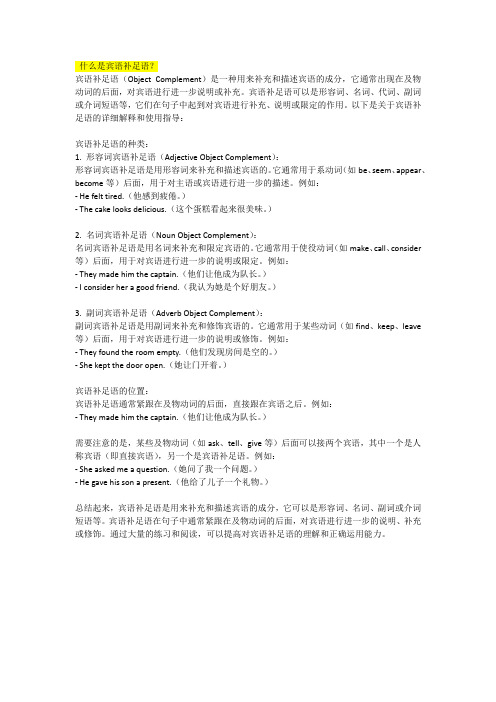
什么是宾语补足语?宾语补足语(Object Complement)是一种用来补充和描述宾语的成分,它通常出现在及物动词的后面,对宾语进行进一步说明或补充。
宾语补足语可以是形容词、名词、代词、副词或介词短语等,它们在句子中起到对宾语进行补充、说明或限定的作用。
以下是关于宾语补足语的详细解释和使用指导:宾语补足语的种类:1. 形容词宾语补足语(Adjective Object Complement):形容词宾语补足语是用形容词来补充和描述宾语的。
它通常用于系动词(如be、seem、appear、become等)后面,用于对主语或宾语进行进一步的描述。
例如:- He felt tired.(他感到疲倦。
)- The cake looks delicious.(这个蛋糕看起来很美味。
)2. 名词宾语补足语(Noun Object Complement):名词宾语补足语是用名词来补充和限定宾语的。
它通常用于使役动词(如make、call、consider 等)后面,用于对宾语进行进一步的说明或限定。
例如:- They made him the captain.(他们让他成为队长。
)- I consider her a good friend.(我认为她是个好朋友。
)3. 副词宾语补足语(Adverb Object Complement):副词宾语补足语是用副词来补充和修饰宾语的。
它通常用于某些动词(如find、keep、leave 等)后面,用于对宾语进行进一步的说明或修饰。
例如:- They found the room empty.(他们发现房间是空的。
)- She kept the door open.(她让门开着。
)宾语补足语的位置:宾语补足语通常紧跟在及物动词的后面,直接跟在宾语之后。
例如:- They made him the captain.(他们让他成为队长。
)需要注意的是,某些及物动词(如ask、tell、give等)后面可以接两个宾语,其中一个是人称宾语(即直接宾语),另一个是宾语补足语。
宾语补足语

宾语补足语是用来补充说明宾语。
可作宾补的有名词、形容词、副词、分词、介词短语和动词不定式。
一、名词、形容词、副词、分词、介词短语作宾语补足语。
e.g We call him Jim.(名词)We must keep our school clean every day.(形容词)Call him in,please.(副词)Leave it on the desk.(介词短语)二、动词不定式作宾语补足语。
可分为三种情况。
1、跟带to 的动词不定式做宾语补足语。
这类动词有:ask叫,tell告诉,advise建议,order命令,get叫,teach教,want想要,expect期望,allow允许,encourage鼓励,wouldlike想要,follow跟随,invite邀请,warn警告等等。
2、跟不带to的动词不定式做宾语补足语。
这类动词有let 让,make使,see看见,watch注视,hear听见,notice注意到,feel感觉到,listento听,look at看have使。
e.g let us have a rest.Let me have a look.This dress makes me look fat.He saw somebody swim in the river yesterday.注意:这种结构变成被动语态时,to 必须加上。
e.g I saw him leave the room with a book in his hand just nowhe was seen to leave the room with a book in his hand just now.3、跟带to或跟不带to的动词不定式做宾语补足语。
这类动词只有help.He always helps me (to) learn English.Can you help me (to) wash my clothes.三、分词做宾语补足语。
宾语补足语
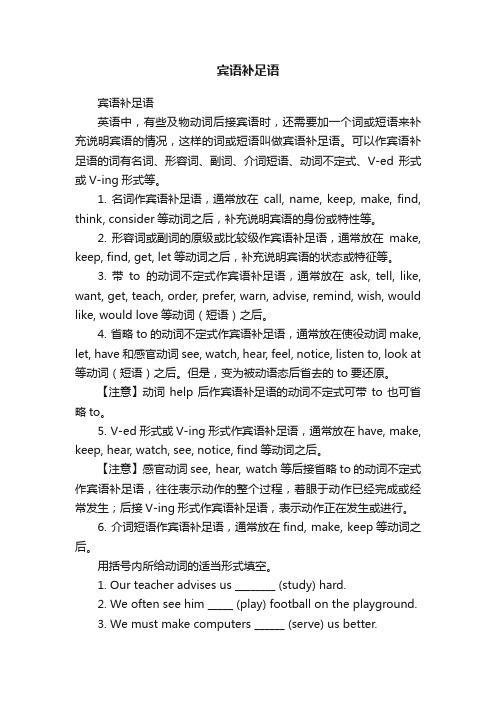
宾语补足语宾语补足语英语中,有些及物动词后接宾语时,还需要加一个词或短语来补充说明宾语的情况,这样的词或短语叫做宾语补足语。
可以作宾语补足语的词有名词、形容词、副词、介词短语、动词不定式、V-ed形式或V-ing形式等。
1. 名词作宾语补足语,通常放在call, name, keep, make, find, think, consider等动词之后,补充说明宾语的身份或特性等。
2. 形容词或副词的原级或比较级作宾语补足语,通常放在make, keep, find, get, let等动词之后,补充说明宾语的状态或特征等。
3. 带to的动词不定式作宾语补足语,通常放在ask, tell, like, want, get, teach, order, prefer, warn, advise, remind, wish, would like, would love等动词(短语)之后。
4. 省略to的动词不定式作宾语补足语,通常放在使役动词make, let, have和感官动词see, watch, hear, feel, notice, listen to, look at 等动词(短语)之后。
但是,变为被动语态后省去的to要还原。
【注意】动词help后作宾语补足语的动词不定式可带to也可省略to。
5. V-ed形式或V-ing形式作宾语补足语,通常放在have, make, keep, hear, watch, see, notice, find等动词之后。
【注意】感官动词see, hear, watch等后接省略to的动词不定式作宾语补足语,往往表示动作的整个过程,着眼于动作已经完成或经常发生;后接V-ing形式作宾语补足语,表示动作正在发生或进行。
6. 介词短语作宾语补足语,通常放在find, make, keep等动词之后。
用括号内所给动词的适当形式填空。
1. Our teacher advises us ________ (study) hard.2. We often see him _____ (play) football on the playground.3. We must make computers ______ (serve) us better.4. My parents told me not _________ (spend) too much time watching TV.5. I saw him _______ (play) basketball when I passed the playground.链接中考1. My roommate often asks me ________ her to play chess.A. teachB. teachingC. to teach2. The woman made his son ______ finally after she told him some jokes .A. laughedB. to laughC. laughD. laughing3. -- I saw Ann ______ a green dress at the school meeting.-- I think she looks better ______ red.A. dressed; inB. put on; wearC. wearing; inD. wear; put on4. The scientist tried his best to make his view ______.A. to understandB. understandC. understoodD. understanding5. The soft music makes me _______ (relax).6. The music makes him ______ (want) to sleep.7. He made me _______(repeat) it.8. The picture makes me _________ (energy).9.Young parents usually don’t know how ________ (make) a baby happy.10.He said again in order to make himself __________ (understand).They also have to know how to make money.他们还必须知道如何赚钱。
宾语补足语定义

宾语补足语定义宾语补足语是在一个句子中用来补充说明或完善宾语的成分。
它可以是名词、形容词、副词、介词短语、不定式、动名词或从句等。
宾语补足语在句子中起到了进一步说明宾语的作用,使句子更加完整,表达更加准确。
宾语补足语可以通过以下几种方式来进行补充说明:1. 名词补足语:宾语补足语可以是一个名词或名词短语,用来进一步说明宾语的身份、特征或属性。
例如:- 他把那本书当作礼物送给了我。
在这个句子中,“礼物”就是宾语补足语,用来说明“那本书”的属性。
2. 形容词补足语:宾语补足语可以是一个形容词,用来进一步描述宾语的状态或特征。
例如:- 她把房间布置得很漂亮。
在这个句子中,“很漂亮”就是宾语补足语,用来描述“房间”的状态。
3. 副词补足语:宾语补足语可以是一个副词或副词短语,用来进一步说明宾语的方式、程度或时间等。
例如:- 她做作业做得非常仔细。
在这个句子中,“非常仔细”就是宾语补足语,用来说明“做作业”的方式。
4. 介词短语补足语:宾语补足语可以是一个介词短语,用来进一步说明宾语的位置、方向或关系等。
例如:- 他把书放在桌子上。
在这个句子中,“在桌子上”就是宾语补足语,用来说明“书”的位置。
5. 不定式补足语:宾语补足语可以是一个不定式,用来进一步说明宾语的目的、用途或动作等。
例如:- 我们需要找一个人帮助我们。
在这个句子中,“找一个人帮助我们”就是宾语补足语,用来说明“需要”的动作。
6. 动名词补足语:宾语补足语可以是一个动名词,用来进一步说明宾语的动作、方式或原因等。
例如:- 我喜欢听音乐。
在这个句子中,“听音乐”就是宾语补足语,用来说明“喜欢”的动作。
7. 从句补足语:宾语补足语可以是一个从句,用来进一步说明宾语的内容、情况或原因等。
例如:- 他告诉我他要去旅行。
在这个句子中,“他要去旅行”就是宾语补足语,用来说明“告诉”的内容。
宾语补足语在句子中起到了补充说明宾语的作用,使句子更加丰富和准确。
宾语补足语

宾语补足语宾语补足语用来补充说明宾语,与宾语一起构成复合宾语。
可作宾语补足语的有名词、形容词、副词、介词和动词不定式等。
(一)、名词、形容词、副词、介词短语作宾语补足语。
如:1.We call him Jim.(名词)我们叫他吉姆。
2.We must keep our school clean every day.(形容词)我们必须每天保持校园清洁。
3.Call him in, please.(副词)请叫他进来。
4.Leave it on the desk.(介词短语)把它留在课桌上。
(二)、动词不定式作宾语补足语可分为三种情况:1.跟带to的不定式作宾语补足语。
常见的这类动词有:ask, tell, get, teach, want, invite, like, allow, wish, encourage等。
如:Tell Jane to sing us a song.叫简给我们唱支歌。
2.跟不带to的不定式作宾语补足语。
常见的这类动词有“一感(feel)、二听(listen to, hear),三让(make, let, have),四看(look at, see, watch, notice)如:Let’s have a rest.让我们休息一会儿。
但这种结构变成被动语态时,to必须加上。
如:He was seen to leave the room with a book in his hand.有人见他手拿着一本书离开这个房间。
3.跟带to或不带to的动词不定式作宾语补足语。
这类动词只有help。
如:Can you help me (to) wash my clothes ? 你能帮我洗衣服吗?(三)、分词作宾语补足语可分为两种情况。
1.现在分词作宾语补足语,经常表示正在发生的动作。
可跟这类补足语的动词有:see, watch, hear等。
如:I hear somebody singing in the next room. 我听见有人在隔壁唱歌。
宾语补足语 英语

宾语补足语英语
在英语中,宾语补足语(Object Complement)是一种语法成分,用于补充说明宾语的状态、特征或身份。
宾语补足语通常出现在及物动词或短语动词之后,与宾语一起构成完整的句子。
以下是一些宾语补足语的常见类型和示例:
1.名词/代词作为宾语补足语:
例如:We elected him president.(我们选他当总统。
)在这个句子中,“him”是宾语,“president”是名词作为宾语补足语,说明“him”的身份。
2.形容词作为宾语补足语:
例如:She found the book interesting.(她觉得这本书很有趣。
)在这个句子中,“the book”是宾语,“interesting”是形容词作为宾语补足语,描述“the book”的特征。
3.动词不定式作为宾语补足语:
例如:My mother asked me to clean the room.(我妈妈让我打扫房间。
)在这个句子中,“me”是宾语,“to clean the room”是动词不定式作为宾语补足语,表示“me”要做的动作。
4.过去分词作为宾语补足语:
例如:I saw the boy playing in the park.(我看见那个男孩在公园里玩。
)在这个句子中,“the boy”是宾语,“playing”是过去分词作为宾语补足语,描述“the boy”的状态。
需要注意的是,宾语补足语与宾语从句不同。
宾语从句是一个完整的句子作为宾语,而宾语补足语则是单词、短语或非完整句子作为宾语的补充说明。
宾语补足语通俗解释

宾语补足语通俗解释宾语补足语是汉语重要的句法结构之一,它是汉语句子的一个重要成分。
它与主语和谓语之间具有密切的联系,是句子成立的关键。
宾语补足语通常由表语、定语、状语、同位语和从句组成,因此理解它的定义和应用对于汉语学习者来说是十分重要的。
一、宾语补足语的通俗解释宾语补足语(Complement)是指一种由宾语、补语和定语组成的句子结构,这种结构被用来补充和完善主句表达的意思。
它可以是任何一种介词、动词、形容词、副词或从句。
宾语补足语是句子补充说明宾语性质、状态、特征和关系的句子成分。
它十分重要,因为它可以把汉语句子的主句细节和背景等信息表达的更加清楚。
实际上,宾语补足语是汉语句子清晰表达含义的重要组成部分,它常常被用来表达主句的特殊性和信息。
宾语补足语有两类:补充性宾语补足语(complementary complement)和解释性宾语补足语(explanatory complement)。
补充性宾语补足语有时也称为表宾语补足语,它是汉语句子的一部分,用来向句子中的宾语提供更多的信息。
解释性宾语补足语有时称为定语补足语,它用来解释宾语或者补充宾语,来表达句子的真实含义。
例如:我给汤姆买一双鞋子。
在这个句子中,“买一双鞋子”就是宾语补足语。
它是补充性宾语补足语,用来表达宾语“汤姆”后面接受动作的对象,即我给汤姆买的是一双鞋子。
二、宾语补足语的重要性宾语补足语在句子结构中占有重要地位,通过它可以向句子中添加更多的信息、补充主句的语义,并强调它们在句子中承担的重要作用。
它可以把句子的本质表达的更加清晰,并可以给句子增加表达的深度。
例如:我喜欢看书。
在这句话中,“看书”是宾语补足语,也是宾语,它向句子中添加了说明“我”的爱好的信息。
如果把宾语补足语改成名词性短语,这句话就可以表达得更加清楚:我喜欢读书。
宾语补足语的另一个重要功能是可以帮助汉语学习者更好地理解句子的含义。
它们可以帮助汉语学习者更好地理解句子的意义,并可以根据句子的结构和内容来推断和分析句子的语义。
宾语补足语七种类型及要点

宾语补足语七种类型及要点宾语补足语七种类型:名词做宾语补足语,形容词做宾语补足语,介词短语做宾语补足语,动名词短语做宾语补足语,不定式做宾语补足语,过去分词做宾语补足语,副词做宾语补足语。
1.名词作宾语补足语例如:We call her Goldilocks.我没叫他小金锁。
2.形容词作宾语补足语例如:My work keeps me busy.我的工作叫我忙个不停。
3.介词短语作宾语补足语例如:I left a case on the train.我落了个箱子在火车上。
4.动名词短语作宾语补足语例如:Don't keep me waiting too long.不要让我怎么样、5.不定式作宾语补足语例如:I asked him to help me.我要他帮我。
6.过去分词作宾语补足语例如:Could you make yourself understood?你能让自己被理解吗?7.副词作宾语补足语例如:Don't let your parents down.不要让你的父母失望。
宾语补足语适用类型:1.在表示心理状态的动词后作宾语补足语。
这类动词有:consider,think,believe,discover,find,imagine,judge,suppose,prove等。
这类动词后的不定式通常是“to be+形容词或名词”结构,think,consider,find后的to be常可省略。
例如:We consider him (to be) a good teacher.我们认为他是一个好老师。
2.在表示情感状态的动词后作宾语补足语。
这类动词有:love,like,prefer,hate,want,wish,expect等。
例如:I'd prefer you to leave him alone.我希望你不要打扰他。
3.注意:hope,demand,suggest等动词后面不能接不定式作宾语补足语。
什么是宾语补足语

什么是宾语补足语?宾语补足语(Object Complement)是英语语法中的一个重要概念。
它是指在句子中作为宾语的补充说明或描述的成分。
宾语补足语通常是名词、形容词、副词或介词短语,用于进一步说明或改变宾语的意义。
宾语补足语可以分为以下几种类型:1. 名词性宾语补足语(Noun Object Complement):宾语补足语是名词或名词短语,用于进一步说明或描述宾语。
例子:- I consider her a good friend.(宾语补足语是名词短语"a good friend",进一步说明宾语"her")- They elected him president.(宾语补足语是名词"president",进一步说明宾语"him")2. 形容词性宾语补足语(Adjective Object Complement):宾语补足语是形容词,用于进一步描述宾语。
例子:- I found the movie boring.(宾语补足语是形容词"boring",进一步描述宾语"the movie")- She considers him intelligent.(宾语补足语是形容词"intelligent",进一步描述宾语"him")3. 副词性宾语补足语(Adverb Object Complement):宾语补足语是副词或副词短语,用于进一步说明或修饰宾语。
例子:- They painted the house white.(宾语补足语是副词"white",进一步说明宾语"the house")-She considered the proposal carefully.(宾语补足语是副词"carefully",进一步说明宾语"the proposal")4. 介词性宾语补足语(Prepositional Object Complement):宾语补足语是介词短语,用于进一步说明或修饰宾语。
宾语补足语七种类型
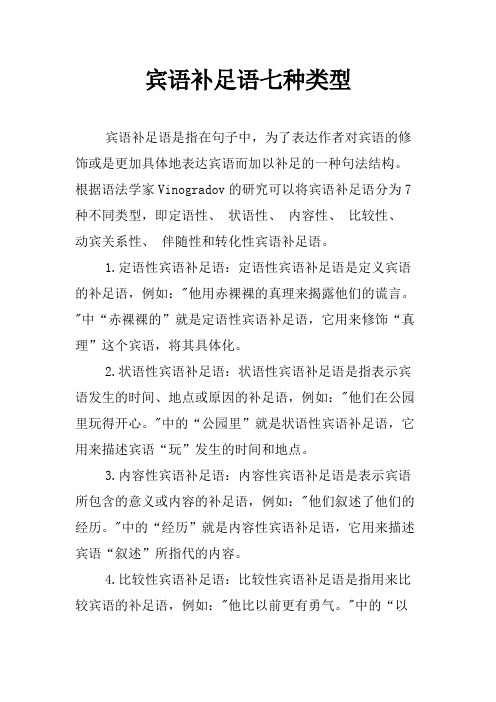
宾语补足语七种类型宾语补足语是指在句子中,为了表达作者对宾语的修饰或是更加具体地表达宾语而加以补足的一种句法结构。
根据语法学家Vinogradov的研究可以将宾语补足语分为7种不同类型,即定语性、状语性、内容性、比较性、动宾关系性、伴随性和转化性宾语补足语。
1.定语性宾语补足语:定语性宾语补足语是定义宾语的补足语,例如:"他用赤裸裸的真理来揭露他们的谎言。
"中“赤裸裸的”就是定语性宾语补足语,它用来修饰“真理”这个宾语,将其具体化。
2.状语性宾语补足语:状语性宾语补足语是指表示宾语发生的时间、地点或原因的补足语,例如:"他们在公园里玩得开心。
"中的“公园里”就是状语性宾语补足语,它用来描述宾语“玩”发生的时间和地点。
3.内容性宾语补足语:内容性宾语补足语是表示宾语所包含的意义或内容的补足语,例如:"他们叙述了他们的经历。
"中的“经历”就是内容性宾语补足语,它用来描述宾语“叙述”所指代的内容。
4.比较性宾语补足语:比较性宾语补足语是指用来比较宾语的补足语,例如:"他比以前更有勇气。
"中的“以前”就是比较性宾语补足语,它用来与宾语“勇气”形成对比。
5.动宾关系性宾语补足语:动宾关系性宾语补足语是指指明宾语与动词之间的关系的补足语,例如:"他发出了声音。
"中的“声音”就是动宾关系性宾语补足语,它用来表示宾语“声音”与动词“发出”之间的关系。
6.伴随性宾语补足语:伴随性宾语补足语是指表示宾语及其他部分共同发生的补足语,例如:"他们带着激动的心情探访了外婆家。
"中的“激动的”就是伴随性宾语补足语,它用来表示宾语“探访”与“心情”共同发生。
7.转化性宾语补足语:转化性宾语补足语是指表示宾语改变方式或形式的补足语,例如:"他把痛苦变成了力量。
"中的“变”就是转化性宾语补足语,它用来表示宾语“痛苦”在变化之后所变成的形式。
宾语补足语
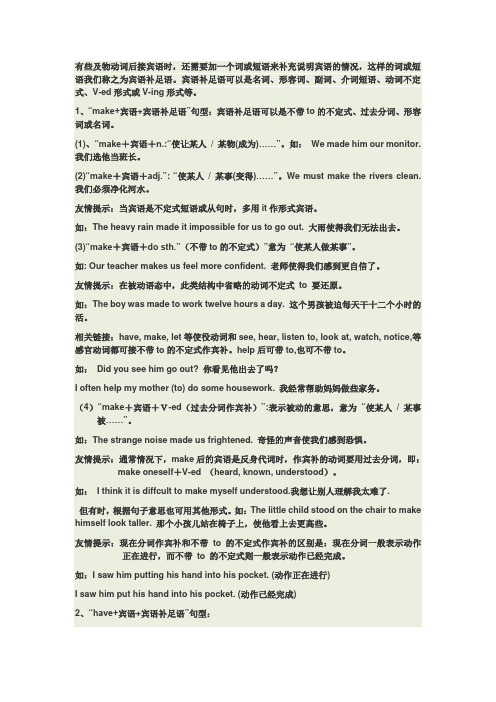
有些及物动词后接宾语时,还需要加一个词或短语来补充说明宾语的情况,这样的词或短语我们称之为宾语补足语。
宾语补足语可以是名词、形容词、副词、介词短语、动词不定式、V-ed形式或V-ing形式等。
1、“make+宾语+宾语补足语”句型:宾语补足语可以是不带to的不定式、过去分词、形容词或名词。
(1)、“make+宾语+n.:“使让某人/ 某物(成为)……”。
如:We made him our monitor. 我们选他当班长。
(2)“make+宾语+adj.”: “使某人/ 某事(变得)……”。
We must make the rivers clean. 我们必须净化河水。
友情提示:当宾语是不定式短语或从句时,多用it作形式宾语。
如:The heavy rain made it impossible for us to go out. 大雨使得我们无法出去。
(3)“make+宾语+do sth.”(不带to的不定式)”意为“使某人做某事”。
如: Our teacher makes us feel more confident. 老师使得我们感到更自信了。
友情提示:在被动语态中,此类结构中省略的动词不定式to 要还原。
如:The boy was made to work twelve hours a day. 这个男孩被迫每天干十二个小时的活。
相关链接:have, make, let等使役动词和see, hear, listen to, look at, watch, notice,等感官动词都可接不带to的不定式作宾补。
help后可带to,也可不带to。
如:Did you see him go out? 你看见他出去了吗?I often help my mother (to) do some housework. 我经常帮助妈妈做些家务。
(4)“make+宾语+V-ed(过去分词作宾补)”:表示被动的意思,意为“使某人/ 某事被……”。
宾语补足语的种类和用法

宾语补足语的种类和用法宾语补足语是指在句子中用来补充说明动词的宾语的成分,它可以是名词、形容词、副词、介词短语等。
宾语补足语的种类和用法涉及到语法的一些细节和规则,下面将对此进行详细讨论。
一、名词性宾语补足语名词性宾语补足语是句子中的宾语补充说明名词,可以是名词、代词、不定式、动名词等。
1.名词宾语补足语名词宾语补足语一般由名词组成,用来进一步说明宾语。
例如:He considered the book a gift.(他把这本书视为一份礼物。
)They elected him chairman.(他们选他当了主席。
)2.代词宾语补足语代词宾语补足语可以是代词,用来补充说明宾语。
例如:I find it hard to understand.(我发现很难理解。
)We made her our leader.(我们让她成为我们的领导。
)3.不定式宾语补足语不定式宾语补足语是用不定式形式的动词来作宾语补充说明宾语。
例如:I want to be a doctor.(我想成为一名医生。
)She asked me to help.(她让我帮忙。
)4.动名词宾语补足语动名词宾语补足语用动名词形式的动词来作宾语补充说明宾语。
例如:I enjoy swimming.(我喜欢游泳。
)They don't mind waiting.(他们不介意等待。
)二、形容词性宾语补足语形容词性宾语补足语是用形容词来修饰宾语,进一步说明宾语的特征。
1.表语形容词作宾语补足语表语形容词作宾语补足语用来补充说明宾语的状态或特征。
例如:She found the movie boring.(她觉得这部电影很无聊。
)We consider him intelligent.(我们认为他聪明。
)2.定语形容词作宾语补足语定语形容词作宾语补足语用来修饰宾语的性质或特点。
例如:They found the city beautiful.(他们觉得这个城市很美。
- 1、下载文档前请自行甄别文档内容的完整性,平台不提供额外的编辑、内容补充、找答案等附加服务。
- 2、"仅部分预览"的文档,不可在线预览部分如存在完整性等问题,可反馈申请退款(可完整预览的文档不适用该条件!)。
- 3、如文档侵犯您的权益,请联系客服反馈,我们会尽快为您处理(人工客服工作时间:9:00-18:30)。
定语从句:定义:在复合句中修饰名词或代词的从句。
先行词:被修饰的名词或代词。
引导定语从句的关系词:关系代词:who, whom, whose, which, that, as关系副词:when, where, why定语从句关系词的选用1.只能用that 不用which 作关系代词的情况(1)当先行词是all, everything, anything, nothing, much, little,none, one 等不定代词时(something 除外)。
(2) 当先行词被all, every, no, some, any, little, much 等修饰(3)当先行词被序数词或形容词最高级修饰时。
(4)如果出现两个或两个以上的先行词,并同时兼指人和物(5) 当先行词被the only, the last, the very, the same 等修饰6)在以疑问词who, which, what 开头的特殊疑问句中,为了避免重复只用that。
7)当定语从句为there be 句型时,关系代词只能用that,也可以省略。
(8)当指人或物的关系代词在定语从句中作表语时,关系代词只能用that,也可以省略。
2.指物只能用which 不用that 的情况(1)在非限制性定语从句中。
如:St.Petersburg, which was once called Leningrad, is a verybeautiful city.圣彼得堡是一座非常美丽的城市,它曾被称作“列宁格勒”。
(2)在介词后面。
如:This is the room in which we lived last year.这是我们去年住的那个屋子。
3.指人时只能用who 不用that 的情况先行词为one, ones, those, anyone, he 时。
如:Those who break the law must be punished.那些违反法律的人必须受到惩罚。
4.“介词+关系代词”引导的定语从句Is this the house in which Shakespeare was born?He paid the boy $10 for washing ten windows, most of which hadn't been cleaned for at least a year.In the dark street, there wasn't a single person to whom shecould turn for help.5.关系代词as 和which 的区别(1)which 引导的定语从句只能位于主句后,但as 引导的从句可位于主句前、中、后。
如:David, as you know, is a photographer. 戴维是个摄影师,你是知道的。
(不可用which)Li Ming is late, as is often the case. 李明迟到了,这事是经常发生的。
(不可用which)(2)as 在定语从句中作主语时,从句谓语通常要有be 或别的系动词,但which 不受此限制。
如:Li Ming was late, which ( =and this) made Mr. Zhang veryangry. 李明迟到了,这件事使张先生非常生气。
(不可用as)(3)as 引导的定语从句只表示一个众所周知或意料之中的事,但which 不受此限制。
如:He married her, which was unexpected. 他和她结婚了,这是出乎意料的。
(不可用as) (4)as 有“正如”之意,而which 则意为“这( 件事,一点)”,可用and this/that/it 来代替(5)as 多用于固定搭配中:as is often the case(这是常有的事),as was expected (不出所料),as often happens (正如经常发生的那样),as is known to all (众所周知),as has been said before(如上所述),as is mentioned above (正如上面所提到的)等。
三、特殊句式1.as 引导限制性定语从句常用句式(1)such+名词+as... 像¡-¡-一样的,像¡-¡-之类的We have found such materials as are used in their factory.(2)the same+名词+as... 和¡-¡-同样的He is not the same man as he was.2.当先行词是way,意为“方式、方法”,在定语从句中作状语时,引导词可以用that/in which/不填。
如:The way that/in which/不填he explained the sentence to us was not difficult to understand.定语从句的习题:1. I‟d skipped nearby Guilin,a dream place for tourists seeking the limestone mountain tops and dark waters of the Li River are pictured by artists in so many Chinese paintings.(2015全国Ⅰ)2.When harvest came around, he was already selling herbs, vegetables and cotton in the market people from the towns met regularly.(2015广东).3.Maybe you have a habit is driving your family crazy.(2014全国Ⅰ).4.The next day, my brother and I went to the beach we watched some people play volleyball.(2014广东).5.People should not do things will disturb their neighbors unnecessarily.(2014湖南).6.In the following years ,there were fewer drop-outs and more college graduates in my village,I am proud of even today.7. Is that the newspaper for you often write articles?8.Can you explain to me how to use these idioms about I am not sure?9.1949 was the year in our country was founded.10. Do you know the man to I spoke just now?st month, part of Southeast Asia was struck by floods from effects the people are still suffering.12.The man pulled out a gold watch, the hands of were made of small diamonds.13.The journey around the world took the old sailor nine months, of the sailing time was 226 days.宾语补足语有些动词如allow, advise, ask, beg, believe, call, cause, enable, encourage, get, invite, order, teach, tell 等后边常跟动词不定式作宾语补足语。
I invited him to come (come)here.He was invited (come) here.The teacher allowed me (finish) my homework on Friday.在make, let, have等使役动词后;在see, watch, look at, observe, feel, hear, listen to, notice等表示感官的动词后省去动词不定式符号“to”。
但如这些词用被动,则带toThat made me (quit)He was heard (reject) the suggestion.-ed 做宾补1.感官动词see, hear, find sb/sth done等2.使役动词have,get, leave, keep等He raised his voice to make himself (hear).We heard the story (tell).We heard the story (tell) when I came in.当动词变成被动时They left the work half (do).The work was left half (do).Her bike was found (steal).-ing做宾补1.感官动词see, hear, find sb. doing等2.使役动词have,get, leave, keep, send, won‟t have sb doing等I found the man (lie) on the ground.Tom kept us (wait) in the wind.The explosion sent us (run) in all directions.I won‟t have my children (say)dirty words.当谓语动词变成被动时The man was found (lie) on the ground.We were kept (wait) in the wind.动词不定式复合结构It‟s difficult for you (study)English.It‟s nice of you(help) me.I feel it right (tell) her the truth.动名词复合结构在句中作主语或宾语等由动名词的逻辑主语即物主代词或名词所有格+动名词短语构成Their (come) to help was a great encouragement to usShe insisted on me/my/her mother(…s) (stay) for lunch当“have”作“有”解释时,如果后面跟有表达某些感情的名difficulty, trouble, problem,fun, a hard time等通常使用动名词,实际上这种句型是在动名词前省去了介词in。
